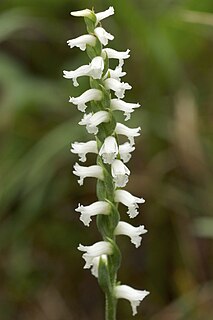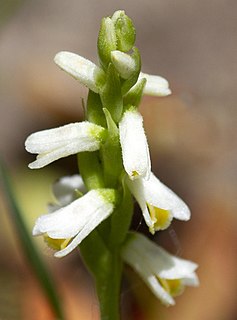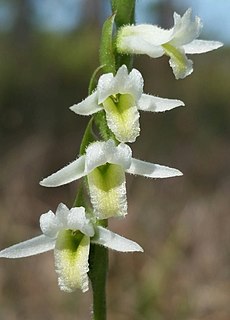
Cypripedium is a genus of 58 species and nothospecies of hardy orchids; it is one of five genera that together compose the subfamily of lady's slipper orchids (Cypripedioideae). They are widespread across much of the Northern Hemisphere, including most of Europe and Africa (Algeria), Russia, China, Central Asia, Canada the United States, Mexico, and Central America. They are most commonly known as slipper orchids, lady's slipper orchids, or ladyslippers; other common names include moccasin flower, camel's foot, squirrel foot, steeple cap, Venus' shoes, and whippoorwill shoe. An abbreviation used in trade journals is "Cyp." The genus name is derived from Ancient Greek Κύπρις (Kúpris), an early reference in Greek myth to Aphrodite, and πέδιλον (pédilon), meaning "sandal".

Caladenia, commonly known as spider orchids, is a genus of 350 species of plants in the orchid family, Orchidaceae. Spider orchids are terrestrial herbs with a single hairy leaf and a hairy stem. The labellum is fringed or toothed in most species and there are small projections called calli on the labellum. The flowers have adaptations to attract particular species of insects for pollination. The genus is divided into three groups on the basis of flower shape, broadly, spider orchids, zebra orchids and cowslip orchids, although other common names are often used. Although they occur in other countries, most are Australian and 136 species occur in Western Australia, making it the most species-rich orchid genus in that state.

Spiranthes is a genus of orchids in the subfamily Orchidoideae. They are known commonly as ladies tresses, ladies'-tresses, or lady's tresses. The genus is distributed in the Americas, Eurasia, and Australia. The genus name Spiranthes is derived from the Greek speira ("coil") and anthos ("flower"), and was inspired by the spirally arranged inflorescence.

Corallorhiza maculata, or spotted coralroot, is a North American coralroot orchid. It has three varieties: C. maculata var. occidentalis, C. maculata var. maculata, and C. maculata var. mexicana. It is widespread through Mexico, Guatemala, Canada, St. Pierre & Miquelon, and much of the western and northern United States. It grows mostly in montane woodlands.

Cypripedium acaule is a species of flowering plant in the orchid family Orchidaceae. It is commonly referred to as the pink lady's slipper or moccasin flower. The specific epithet acaule means "lacking an obvious stem", a reference to its short underground stem, for which reason the plant is also known as the stemless lady's-slipper. It is the provincial flower of Prince Edward Island, Canada and the state wildflower of New Hampshire, United States.

Platanthera blephariglottis, commonly known as the white fringed orchid or white-fringed orchis, is a species of orchid of the genus Platanthera. It is considered to be an endangered species in Connecticut and Ohio, a threatened species in Florida, Maryland and Rhode Island, exploitably vulnerable in New York, and susceptible to be threatened in Québec.

Crepidium, commonly known as 沼兰属 or spur orchids is a genus of about three hundred species of orchids in the family Orchidaceae. Plants in this genus are evergreen, mostly terrestrial plants with short stems lying on the ground, two or more relatively large, pleated leaves and small, non-resupinate flowers with spreading sepals and petals. The genus is widely distributed in the tropics.

Spiranthes cernua, commonly called the nodding lady's tresses, is a species of orchid occurring from Maritime Canada to the eastern and southern United States. As the common name suggests cernua means "nodding," or "bowed" in Latin.

Suaeda nigra, often still known by the former name Suaeda moquinii, is a species of flowering plant in the amaranth family, known by the vernacular names bush seepweed or Mojave sea-blite.

Corallorhiza odontorhiza, common name fall coral-root or small-flowered coral-root, is a species of orchid widespread across eastern and central United States, and reported also from Mexico, Central America, Quebec and Ontario. In North America, it occurs in forested areas up to an elevation of 2800 m.
Malaxis bayardii, or Bayard's adder's-mouth orchid, is a species of orchid native to northeastern North America. It is found from Massachusetts to North Carolina, with isolated populations in Ohio and Nova Scotia. There are historical reports of the plant formerly growing in Vermont and New Jersey, but it seems to have been extirpated in those two states It grows in dry, open woods and pine barrens at elevations of less than 600 m.

Liparis liliifolia, known as the brown widelip orchid, lily-leaved twayblade, large twayblade, and mauve sleekwort, is a species of orchid native to eastern Canada and the eastern United States. It can be found in a variety of habitats, such as forests, shrublands, thickets, woodlands, and mountains. The orchid is considered globally secure, but it is considered rare or endangered in many northeastern states.

Spiranthes lucida, the shining ladies'-tresses, is a species of orchid native to northeastern North America.

Spiranthes arcisepala, the Appalachian ladies' tresses, is a species of flowering plant in the family Orchidaceae. This orchid is native to eastern North America. Long treated as part of Spiranthes cernua the species complex was reevaluated and Spiranthes arcisepala established as a separate species in 2017.

Spiranthes torta, the Southern ladies’ tresses, is a terrestrial orchid native to Florida, Mexico, Central America, the Caribbean Islands and Bermuda.

Spiranthes brevilabris, the short lipped ladies' tresses or Texas lady's tresses is a rare and endangered orchid native to the southeastern United States.

Spiranthes longilabris, the Long Lipped Ladies' Tresses is an orchid endemic to the southeastern United States.

Spiranthes laciniata, the lacelip ladies' tresses is a terrestrial orchid endemic to the south eastern United States.

Spiranthes bightensis, the Atlantic ladies tresses, is a terrestrial orchid native to coasts of the north-eastern United States.
Spiranthes igniorchis, or fire ladies' tresses, is a species of orchid endemic to Florida.



















